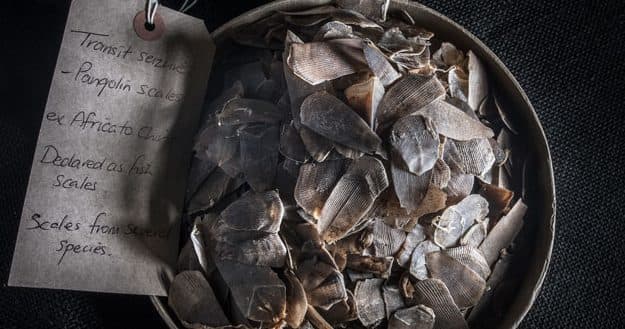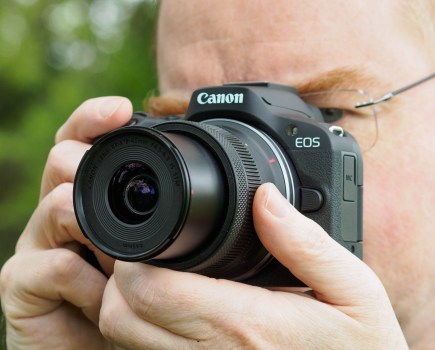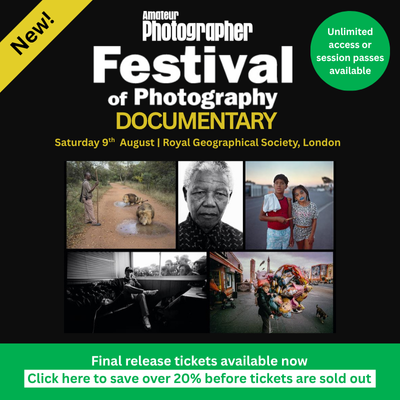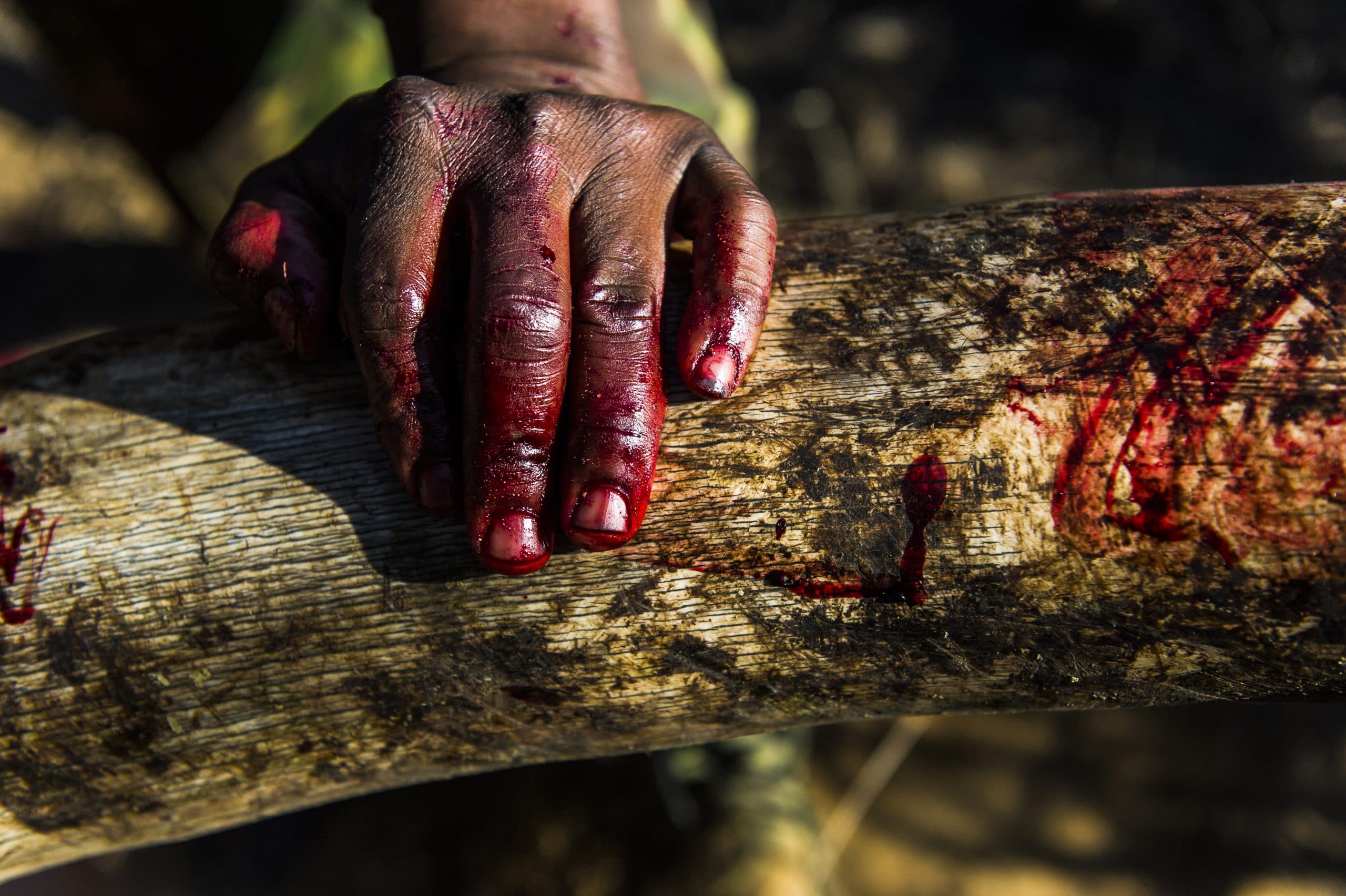
A ranger’s bloody hand rests on an ivory tusk during an anti-poaching mission in KwaZulu-Natal, South Africa
© Peter Chadwick / Photographers Against Wildlife Crime™
Photography has the power to inform, influence and change the way people think and behave. Although by its nature photography is a very singular pursuit, sometimes a group of like-minded photographers combine their efforts for a common purpose on a project that has the potential to be greater than the sum of their individual frames. Photographers Against Wildlife Crime is one such collaboration and for the last couple of years this group of leading wildlife photojournalists and other contributors have combined their talents to produce two acclaimed photo books documenting the realities of the global wildlife trade.
The idea for such a book came about after I met the wildlife photojournalist Britta Jaschinski for an interview about her work, which included a series of shocking black & white images exposing the plight of China’s ‘bile bears’, many of which are held for years in crush cages, their stomachs tapped daily with a catheter to remove the bile for use in traditional Chinese medicine. She emphasised that the wildlife trade was so much bigger than bile bears in crush cages. After numerous meetings and discussions, we came up with the idea of inviting other photographers we admire and respect to produce a powerful, haunting and yet beautiful book that tells the truth about the illegal wildlife trade.
These were photographers who had been covering this subject for many years, usually through their own initiatives. The book, she stressed, should reach a global audience, using powerful photography, social media and publicity to help bring an end to the illegal trade in our lifetime. Of particular concern to us was China; as the world’s largest market for wildlife products, getting this message and the work of these photographers to the Chinese consumer was our ultimate objective. Together, we would choose stories and photos to create a unique book exposing the reality of this multi-billion-dollar crime. And so, our concept was born.
Award-winning experience
As first recruits, Britta believed it important to gain the support of two of the most prominent photographers working in this area, former Wildlife Photographer of the Year winners Brent Stirton and Michael ‘Nick’ Nichols. This was the beginning and both photographers each shot a promotional video to support our crowdfunding campaign. Another renowned photojournalist who joined the group was Paul Hilton, who has over 20 years’ experience of documenting Southeast Asia’s worst wildlife crime excesses, including shark finning and the trafficking of pangolins. He firmly believed that only by getting as many like-minded photographers working together could we possibly begin to make a difference in China.
The official launch of Photographers Against Wildlife was announced in the Guardian Online in October 2017, with an extensive gallery of 20 images. It proved pivotal to the success of the launch as there was immediate pick-up from other online and print media outlets all over the world. The subsequent sharing of links to our website and crowdfunding pages saw a steady stream of pre-publication orders and our funding target was reached nearly twice over. From then on, printing the book was no longer a dream but a serious responsibility.
Deadly realities
In early April 2018 we travelled to Italy to see the presses roll: 184 pages, with 100 photographs by 24 of the world’s most committed wildlife photojournalists documenting the deadly reality of animal abuse, poaching and trafficking. The book also included poignant studies of the heroes on the ground who rescue and rehabilitate the survivors of this deadly trade. Depicting this contrast of horror and heroism was an important element of the overall content and the ease with which the photographers switched between the two also provided further evidence of their exceptional abilities. This is no ordinary group of photographers: each has extensive experience of using their cameras to photograph the harsh and upsetting realities of wildlife crime. Some, like Karl Ammann, have been documenting the hunting of Africa’s great apes for more than 30 years; Stirton and Nichols are renowned for their photographs of the brutal slaughter behind the trade in rhino horn and elephant ivory; Steve Winter is at the forefront of the fight to prevent Asia’s last wild tigers from being poached to extinction, while others such as Adam Oswell have established their own NGOs to provide enforcement assistance to counter the illegal trade.

A pangolin and her baby, most likely to be sold to a restaurant kitchen in Vietnam or China © Paul Hilton / Photographers Against Wildlife Crime™
We also had major contributions from investigative journalist Sharon Guynup, a stirring foreword by Roz Kidman Cox, chair of the Wildlife POTY jury, and a poignant afterword by the legendary Jim Brandenburg, giving voice to the fears of the wolf, perhaps the most persecuted wild animal of all.
A bigger ambition
The book was officially launched in May 2018 with an accompanying exhibition at the Leica Gallery in London. Since then, exhibitions and speaking engagements have followed in Switzerland, Germany, France, Spain, Norway, South Africa and the Netherlands. The exhibition in France was particularly memorable – an autumnal outdoor display at the Montier-en-Der International Festival of Animal and Nature Photography, which attracted more than 40,000 visitors.
Even though the book was printed in English only, it sold out in less than a year, with orders from over 50 countries, including China. This sales success meant Britta and I could fulfil our bigger ambition of producing a specially designed Chinese and English bilingual edition for the Chinese market. This new edition launched in October 2019, and it is far more than a translation – the book now includes work by 32 photographers and has been completely redesigned with 64 extra pages and 41 new images.
Among the new photo stories are Tim Laman’s exposé of the trade in helmeted hornbills for ‘red ivory’ and Aaron Gekoski’s searing images of animal abuse in Southeast Asia’s zoos and wildlife parks. There are new stories of hope too, including Marie-Claire Greve’s account of elephant translocations in Africa and Roy Mangersnes’s uplifting tales of Chinese conservation efforts to preserve a newly discovered species of gibbon and the only valley in China where three species of hornbill can be found.
Britta was able to promote the bilingual edition directly with her most recent talk, Wildlife or Commodity, a 60-minute address to a packed theatre in Guangzhou, China. Her appearance was organized by YiXi Talks, which translates as ‘Get Inspired’, and is China’s equivalent of Ted Talks.
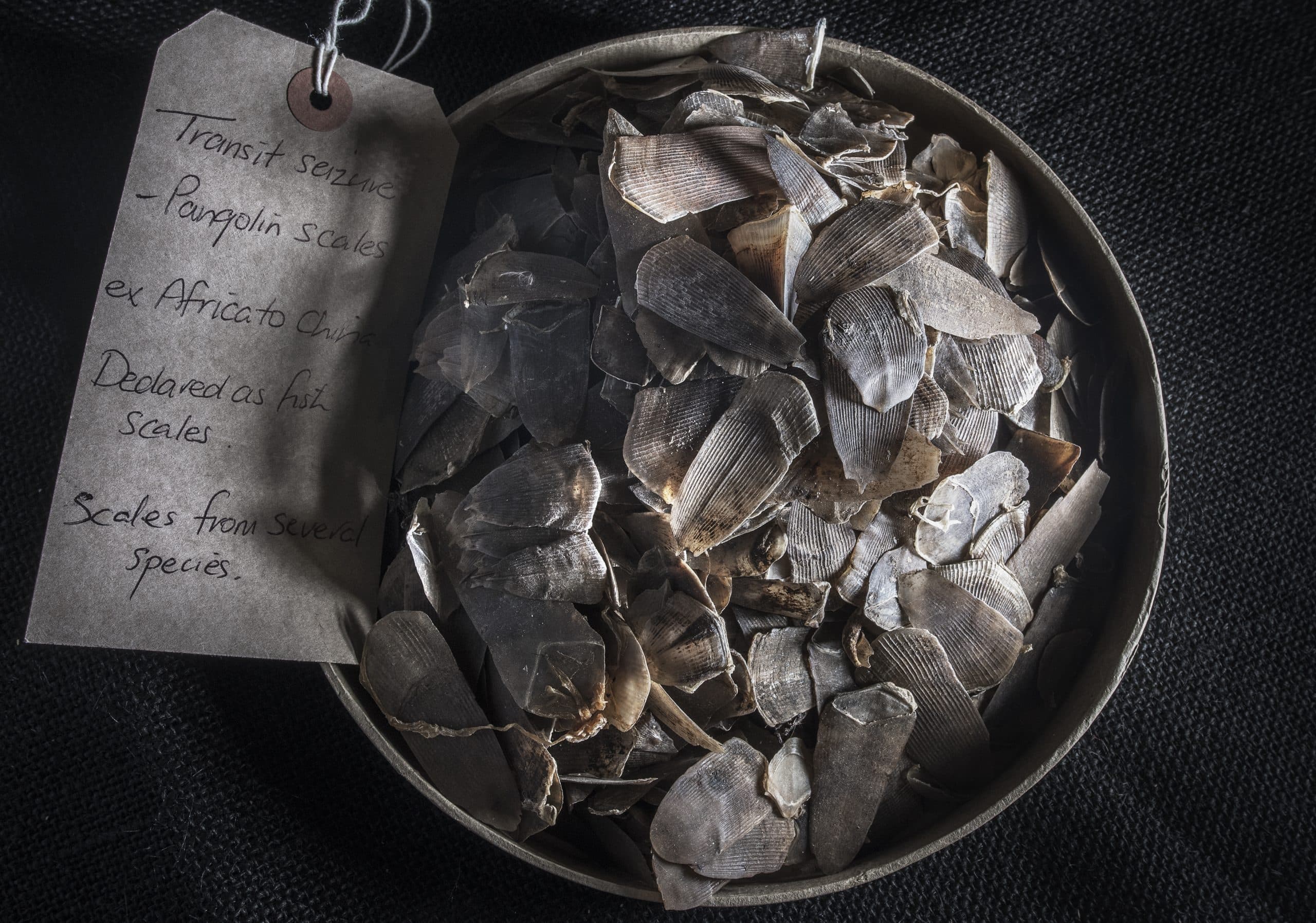
Pangolin scales seized in transit from Africa to China, at Heathrow Airport © Britta Jaschinski / Photographers Against Wildlife Crime™
Chinese reaction
As she spoke, each sentence was meticulously translated to the audience, some of whom were simultaneously making online posts on WeChat, China’s equivalent of Facebook. Carefully arranged slides of her work and other images by Photographers Against Wildlife Crime, were displayed on a huge cinema-style screen, adding power as well as visual evidence to the horrors she described: grim bile bear cages; confiscated pangolin bodies; trays of shark fin drying in the midday sun, and starving big cats performing circus tricks. None of these photos made for comfortable viewing, but their significance was even more profound for this audience because China is the world’s largest market for wildlife products.
So how did her listeners react to such stark, uncompromising imagery about an issue that continues to damage China’s reputation in the eyes of the West? ‘The people I met were full of tears and very emotional,’ she recalled when we met in London after her trip. ‘They showed me the WeChat posts they had already done during my talk and I was deeply moved by that because they fully understand what’s going on, they understand what needs to be done.’
Of course, there is more to informing the public and raising awareness than by copy sales and talks alone. Since early 2019, some of the images and stories from Photographers Against Wildlife Crime have been used in a social media campaign in Hong Kong to educate the public and inform justice and legal professions about the city’s role as a major transit hub for the illegal wildlife trade. Encouragingly, seizures of wildlife contraband, especially ivory, rhino horn and pangolin scales, increased significantly in the past year, while local initiatives led by ADM Capital Foundation and Wildlife Crime Hong Kong continue to seek tougher penalties and powers of enforcement for Hong Kong’s police and administrators.
Confiscation and rewards
China too has started making more frequent seizures. Indeed, minutes after her talk Britta heard first-hand how the Chinese public is helping to tackle the trade. She told me: ‘I felt encouraged walking off stage and talking to people afterwards. They want to take part in bringing change and there were people from the audience saying to me, “are you aware that the Chinese government now gives actual rewards to people who help confiscate items and bring the people involved to justice?” I learned that there and then. This is what China does, which is amazing.’
Further evidence of China’s focus on fighting the illegal wildlife trade became apparent a few days after Britta’s talk when China Daily, the official English language newspaper of the Chinese government published the cover of the book on its front page with the words: ‘Picture power. How photography can help fight against wildlife crime’. The accompanying story inside included the following quote by Steve Winter: ‘It’s a small percentage of people who are responsible for this trade, but the whole country is damaged by the label. But young people have no desire to use endangered species products. If you have the University of Beijing saying these animal body parts have no medicinal value, they hear that and it becomes something we hope they will tell older family members too.’
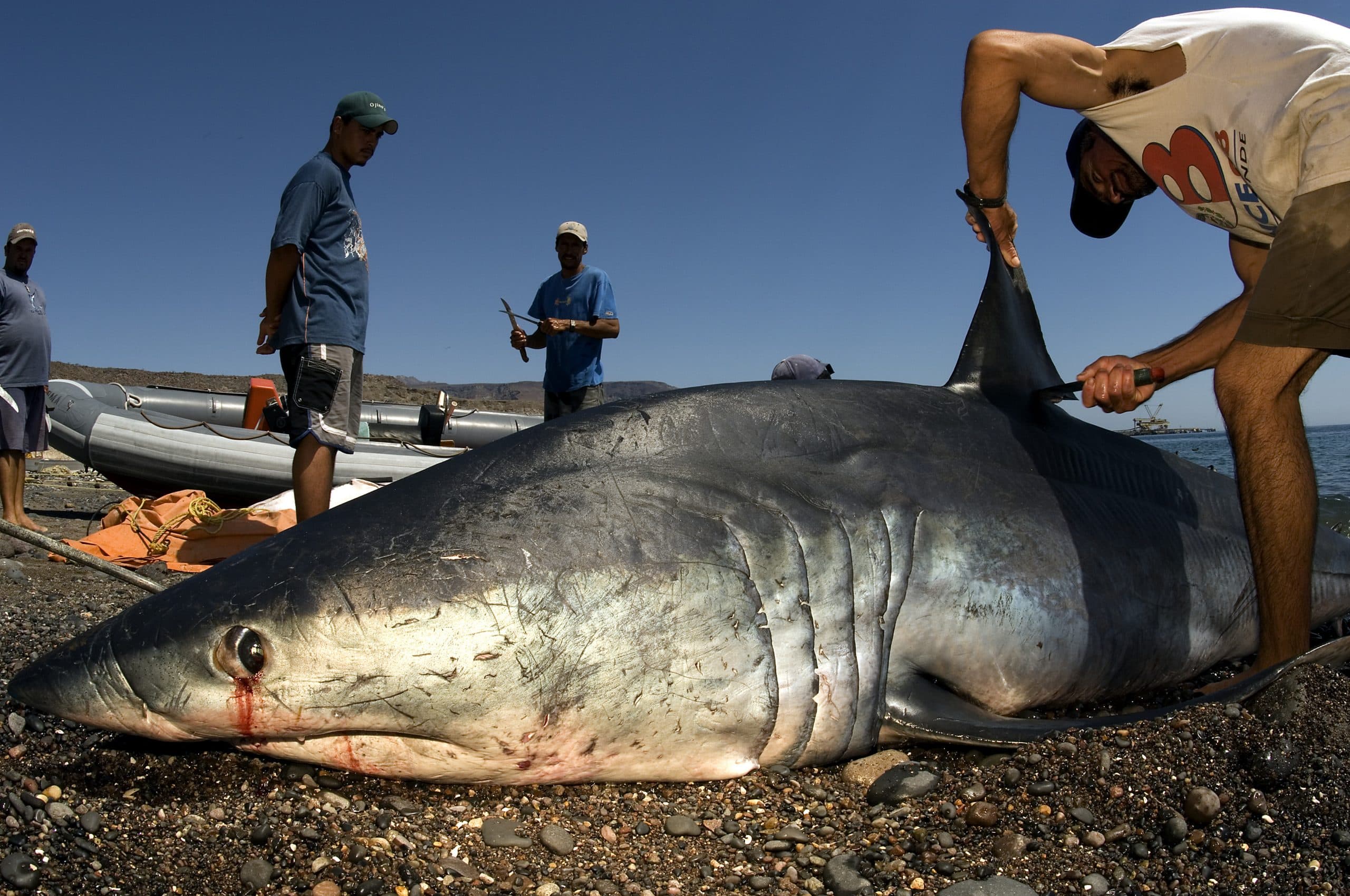
Each year, over 70 million sharks are killed for fins. Most are taken by Taiwan, Mexico, Indonesia, Japan and India © Brian Skerry / Photographers Against Wildlife Crime™
In addition to these remarks in a state-run newspaper, the book also gained prominent coverage in the October 2019 edition of the Beijing-based magazine Esquire China, with no fewer than ten pages of extracts. Esquire’s audience mostly consists of aspiring, professional-class men with plenty of disposable income, some of whom may view the conspicuous consumption of wildlife products such as shark fin soup, or hangover tonics made from rhino horn, as expressions of wealth and status. Hopefully, these pictures make them and their peers think again.
Positive engagement
So far, our engagement with China has proved positive and we have since added two new contributors, the Chinese photographers Yongqing Bao and Shangzhen Fan. Both were category winners in the 2019 Wildlife Photographer of the Year awards, with Yongqing receiving the coveted grand prize, the first Chinese entrant to do so in the competition’s 55-year history. The success of these photographers combined with the breakthrough coverage of the book in China has left Britta and I feeling more positive about seeing an end to the illegal wildlife trade in our lifetime. It is a view shared by Brent Stirton, who recently remarked: ‘I think this book started as one thing and then took on a life of its own as more photographers signed up and their work was seen by a wider audience. The fact that this book made it into China and has been well received genuinely gives me hope that educating the Chinese as to the consequences of some of their choices can eventually save many of our precious remaining animals. We can’t demonise people who have no grasp of that. This book helps to move us closer to understanding trade, consumption and consequence. That has to be a good thing.’
Thankfully, through the power of photography demonstrated by every contributor to Photographers Against Wildlife Crime, there are new signs of more concerted efforts to end the trade. It is a view backed up by Steve Winter: ‘Being a part of a group of passionate dedicated photographers like Photographers Against Wildlife Crime is a real honour. The hardest part – putting this passion into real world change – happens when you stand together and in one voice speak for the ones without a voice. Britta and Keith have taken our message and lit a fire of concern and a desire to bring about change in China, where much of the species are being consumed. This is nothing short of incredible and we as a group are proud our images can win for the animals – if we stand as a group and work together.’
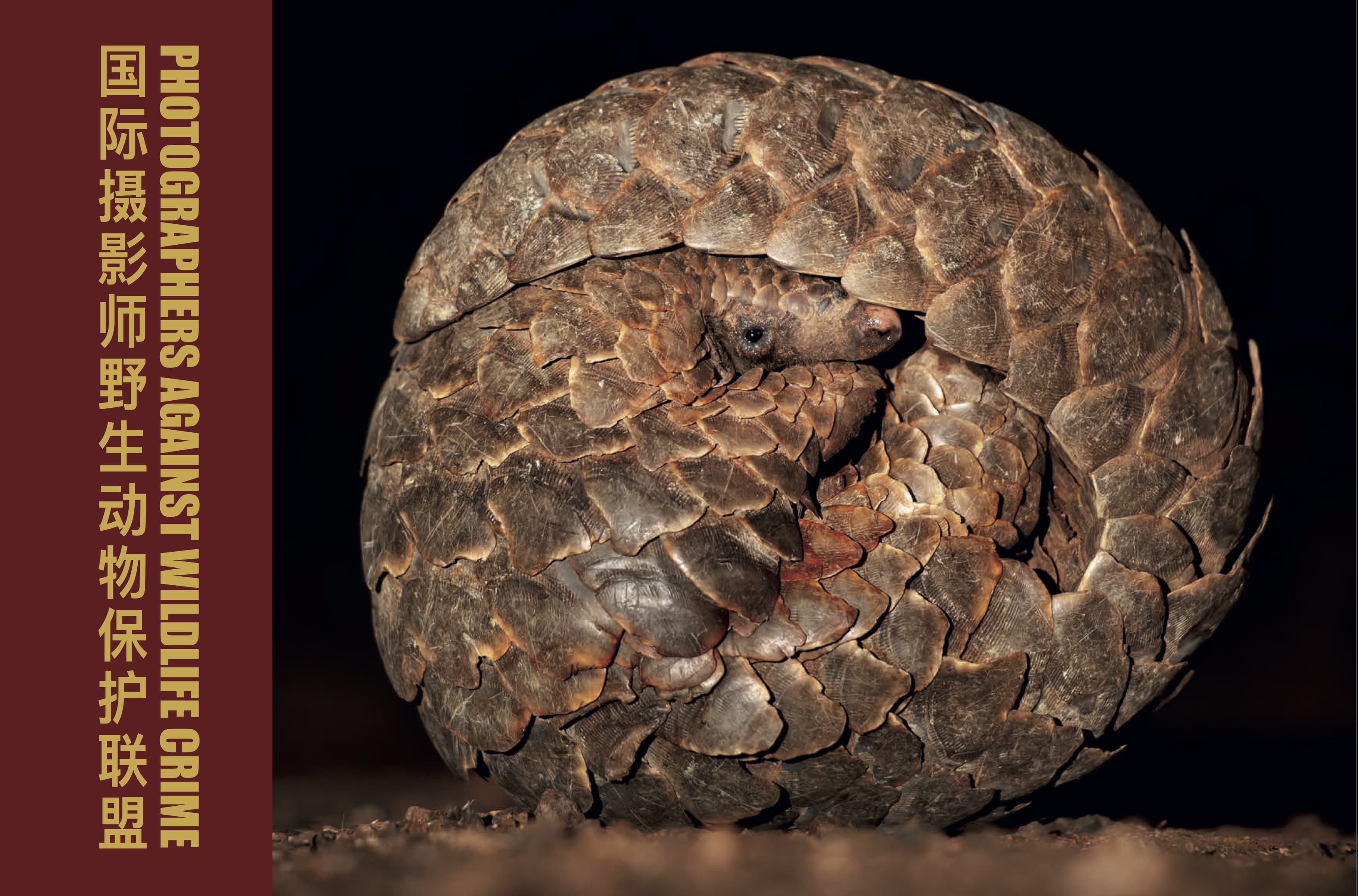 Photographers Against Wildlife Crime™ (special English and Chinese edition).
Photographers Against Wildlife Crime™ (special English and Chinese edition).
The book costs £60, and can be ordered here.
Co-editors / project creators: Britta Jaschinski/Keith Wilson. Writer: Keith Wilson. Designer: David Griffin. Introduction: Rosamund Kidman Cox OBE. Afterword: Jim Brandenburg. Printer: F&W Druck & Mediencenter, Germany
photographersagainstwildlifecrime.com
THE PHOTOGRAPHERS
Aaron Gekoski | Adam Oswell | Adrian Steirn | Brent Stirton | Brian Skerry | Britta Jaschinski | Bruno D’Amicis | Charlie Hamilton James | Chris Packham | Christian Ziegler | Daniel Beltrá | Jim Brandenburg | Joan de la Malla | Jo-Anne McArthur | Johan Marais | Karl Ammann | Klaus Nigge | Marie-Claire Greve | Michael ‘Nick’ Nichols | Neil Aldridge | Ole J Liodden | Patrick Brown | Paul Hilton | Peter Chadwick | Roy Mangersnes | Shangzhen Fan | Steve Winter | Sudhir Shivaram | Thomas P Peschak | Tim Laman | Tony Wu | Vincent Munier | Xiaoqun Zheng |Yongqing Bao

